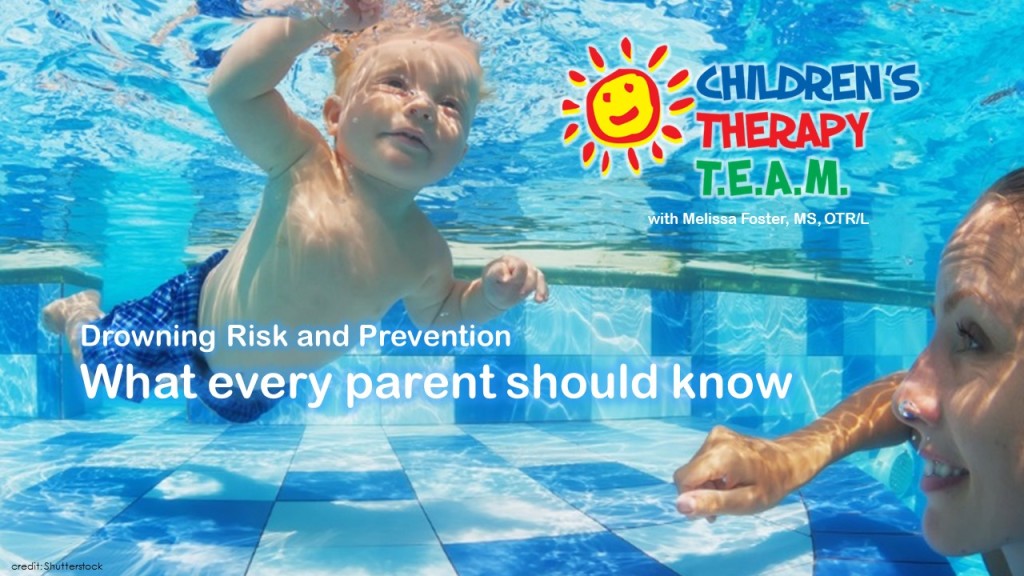This week’s blog is not a parent question. Rather, it was a request my own mother made last year – to run a water-safety blog at the beginning of summer each year. So, in discussing the special needs child: drowning risks and prevention, I begin with current statistics on drowning.
According to the CDC (downloaded June 2016):
- From 2005-2014, there were an average of 3,536 fatal unintentional drownings annually in the United States —about ten deaths per day.
- Approximately one in five people who die from drowning are children 14 and younger.
- Drowning is the leading cause of injury-related death among children between 1-4 years of age.
- For every child who dies from drowning, another five receive emergency department care for nonfatal submersion injuries.
* More than 50% of drowning victims treated in emergency departments (EDs) require hospitalization or transfer for further care (compared with a hospitalization rate of about 6% for all other unintentional injuries). These nonfatal drowning injuries can cause severe brain damage that may result in long-term disabilities such as memory problems, learning disabilities, and permanent loss of basic functioning (i.e., permanent vegetative state).
Drowning is of particular concern for children with Autism.
According to the National Autism Association (June 2016), the risk of death by drowning is twice as high for children with ASD than in the general population. In 2009, 2010, and 2011, accidental drowning accounted for 91% of injury-related deaths in the U.S among children with ASD ages 14 years and younger. Many factors contribute to this high mortality rate, including wandering, seizures, and a general lack of safety awareness.
What should we do?
Here are some things you can do to help protect your children:
- Teach your kids to swim! For families with children with special needs, the comparatively high risk of drowning makes learning to swim even more imperative. As a life skill, learning to swim can be a goal targeted with a child’s occupational therapist and/or physical therapist. Children’s Therapy TEAM’s Aquatic Center is a great point of reference for families who seek an option specifically designed and individualized for their child with special needs. There are also options such as the Boys & Girls Club, American Red Cross, private pools/clubs (you don’t always have to be a member to participate), local colleges/universities, word of mouth private teachers, etc.
- Know your child’s personality/abilities. Does your child have Autism, ADHD, or is he impulsive? Know your child’s temperament and if he tends to be a risk-taker or not. If he is the risky type, be even MORE vigilant than you would otherwise. However, don’t just assume that your very timid child who won’t even put his face in the water is automatically safe because he is timid. For example, my extremely timid 6 year old son was drying off one day after a swim lesson at a public pool. I turned my back for just a minute, and found him clinging to the side of the pool. In the water. At the deep end! (Insert heart attack here!)
- Underestimate your child’s swimming ability. Yes, your child may have passed the check list as a beginner swimmer, and yes, he may be able to swim across the deep end of the pool. But don’t just assume that he can swim well enough to keep himself safe. When it comes to water safety, maintain extra vigilance with less than ideal swimming conditions such as the lake, swim parties, canoeing, the ocean, etc. It is also important to share your child’s swimming abilities (or lack thereof) with any camp counselors, babysitters, or family friends who might be taking your child swimming. It is always a good idea to insist that your child wear a life jacket, just in case. Yes, many children will balk at the idea of continued use of the life jacket, but the rules are there for a very important reason.
- Watch for both a LACK of supervision as well as a LAPSE in supervision. Another personal true story: When my daughter was 3 years old, we went swimming with extended family while on a vacation. I was actually IN the water, sitting on the pool steps, my daughter within arm’s reach. I turned my head to watch my niece doing a flip in the pool. I turn my head back, and my daughter is completely silent, under water, no splashing. She had simply taken that one step too far toward the deep end, and could no longer keep her head above water in the “shallow end.” Scary. According to Autism/Aspergers Digest, 90% of drowning deaths occur while the child is being supervised. Unlike what you see in the movies, drowning is generally silent. No splashing. No screaming. Silent. Again, scary.
- Make your home pool Fort Knox. The CDC recommends 4-sided fencing at least 4 feet tall. This fence should include a self-closing and self-latching gate, with the latches being out of reach of children. Additionally, move pool furniture away from this fence so that it can’t be used as a step stool. Make sure pool toys are not left in the pool. Install a pool alarm to alert you if the pool water is disturbed. Lock back doors/gates to create additional barriers to the pool area. The more layers of protection you have surrounding the pool, the less likely a child will wander off and decide to go for a dip, alone.
Yes, swimming is excellent exercise and a great way to cool off in the summer. Just make sure your child is safe and supervised. And by the way, don’t forget the sun block!
Resources:
Children’s Therapy TEAM Aquatic Center, Northwest Arkansas
Swimming Pool Safety, HealthyChildren.org (downloaded June 2016).
Home Pool Safety, American Red Cross (downloaded June 2016).
Water Safety: The Ultimate Life Skill, Autism/Asperger’s Digest, July/August 2010.
Water Safety at Home, Safe Kids Worldwide, (downloaded June 2016).
Unintentional Drowning: Get the facts, Centers for Disease Control, (downloaded June 2016).

